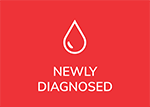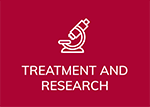
By Linda Brandt Myers – Patient
ITHACA, N.Y. In May 1994, on the eve of my marriage to my husband, Sandy, I was diagnosed with chronic lymphocytic leukemia (CLL).
I remember hearing my oncologist tell me I had ten years to live (what he actually said was more like: “The average length of time a CLL patient your age [I was 51] and stage, 1.5 on the Rai scale, can expect to live is ten years.”).
Sandy’s look showed he had no intention of losing me that soon, and I told myself that I wasn’t going to lose me either. The only problem was we had no idea how we’d save me.
Over the next decade and a half I had chemotherapy three times and got three good remissions, thanks to my local oncologist, Dr. Charles Garbo, and the protocols he followed, devised by my CLL specialist, Dr. Michael Keating, at MD Anderson Cancer Center.
Unfortunately I relapsed four times, plus after my last relapse, in July 2011, my lymphocyte count began climbing aggressively again.
“The big, bad wolf is back, and he’s bigger and badder than ever,” I wrote in my journal. “Will this be the time he catches and devours me? Or will I escape again by the skin of my teeth?” (Perhaps I’d been reading too many children’s books to my grandkids.)
I did know that if I wanted to survive I had only two viable options: get a high-risk stem cell transplant or seek out a drug still in clinical trials.
When I was first diagnosed with CLL in 1994, there had been no active Internet, and it wasn’t easy for a patient like me to find out more about my disease. Thankfully, by 2011 things had changed.
Among the useful websites in cyberspace that I found that year was “CLL Topics.” One of the first CLL patient empowerment sites, it was created and maintained by science writer Dr. Chaya Venkat, who translated complex medical documents about CLL research into plain English for us patients — and used her site to prompt more progress. CLL Topics was a labor of love for her, honoring her late husband, P.C. Venkat, who’d died following a stem cell transplant for his own CLL.
That December, I read a piece in “CLL Topics” by Dr. Venkat about an upcoming clinical trial at the National Institutes of Health in Bethesda, MD, with a new drug she’d been hailing. The drug, a Bruton’s tyrosine kinase inhibitor then called PCI 32765 (it’s now known as Ibrutinib), didn’t offer a cure but promised a new approach to living with CLL longer. I was intrigued.
Another plus: the trial was open to patients 65 years and older (I was 69 then), while many other trials had age restrictions.
So I sent an email to the principal investigator, Dr. Mohammed Farooqui, and he wrote back encouragingly but asked for many medical records, which I sent.
Several months went by. You can imagine my relief when Dr. Farooqui’s team, headed by Dr. Adrian Wiestner, invited me to visit them at the NIH in on the last day of February 2012 to be evaluated for the clinical trial.
Sandy and I took time off from work and made the seven-hour drive from our home in central New York to Bethesda. The next morning we took a shuttle van from our hotel to the clinical building at the heart of the NIH complex.
The largest biomedical research center in the world, it’s a U.S. government facility, so I wasn’t surprised when staff in uniform at the entrance to the campus asked us to disembark, go through security and show our passports to get the special photo badges that allowed us to enter the complex.
The clinical building itself was bright and welcoming, with a sunny atrium, art on display, a café, gift shop and helpful staff. And Drs. Farooqui and Wiestner, physician assistant Janet Valdez, nurse Susan Soto and the rest of the team I met on the 7th floor seemed dedicated and knowledgeable and answered all our questions about the details of the trial.
There were to be two cohorts. One group’s members all needed to have active CLL and a particular genetic deletion, “17p,” that interfered with their responsiveness to current treatments other than the risky stem cell transplant. The second group was to be made up of people over 65 who did not have the 17p genetic deletion but had active CLL and prior treatment (I would be in that group, if accepted into the trial).
The hope was that the new drug would work for both groups.
We drove home exhausted from trying to absorb so much information in such a short time, but also hopeful about the drug, which if it worked, had the potential to save my life and the lives of so many others.
Two weeks later I was formally accepted into the trial. At that point my white blood count was over 105,000, close to double what it had been less than a month earlier, and my spleen had started to swell.
“Right now it’s our absolute best hope,” I wrote in my journal about the trial.
All participants were to visit the NIH clinical center every two weeks for the first two months. Then, if all went well, we’d taper off to quarterly visits. Transportation for patients (but not partners) would be arranged and paid for through the in-house travel agency, and hotel accommodations, which we were to arrange ourselves, would be partly reimbursed.
In the interim between visits I was to stay in touch with Dr. Farooqui and the team by phone and email and report any health problems. The trial drug would be provided free by the drug company that made it. And I was free to drop out anytime.
During my next visit, I signed papers indicating I’d agreed to participate in the study, then underwent a full-body CT scan so that there would be a picture of my swollen lymph nodes for later comparison. I also had lymph node and bone marrow biopsies as well as blood drawn — tubes and tubes of it — and tested.
But it was all part of the show I’d signed on for, and I felt positive about my future for the first time in a long time as well as even a little brave, I told Sandy.
When we got home and I opened the first bottle of the drug I saw that the capsules were battleship gray, which made me think about the battle that would be going on in my body once I took them. What would it feel like? Suddenly, I was not so brave.
“This is serious, life-threatening business, a leap into the unknown,” I wrote in my journal. “I need to be able to tolerate the drug. I need it to continue to work and have it provided beyond the trial — forever.” And then, recalling how I’d felt prior to chemo: “It’s too, too hard to be going through something like this again.”
With effort, I brought my mind back to the practical business at hand. I needed to remember to take three of the capsules, 420 mgs., once a day, and not to eat anything for two hours before or at least 20 minutes after — easy to say, but also easy to forget, I would learn. And I had to return all empty bottles to my NIH team —another thing to remember.
The drug was supposed to flush out all the nasty leukemic cells hiding in my lymph nodes and deposit them in my bloodstream, where they would self-destruct. But before they did, my doctors cautioned, there would be a big pileup soon after the start of the trial, likely doubling my current lymphocyte white blood cell count. But I was not to worry because that number would eventually drop down to close to normal levels.
I can’t remember how long it took before I felt the deep chills – maybe a week. They would arrive sometime in the morning and didn’t lift until evening. During the day I’d pile on layers of sweaters as if it were winter, not spring. I felt like I was living inside a refrigerator. But when I took my temperature, surprisingly it was normal.
I called Dr. Farooqui and asked: “Is everyone in the trial feeling this way?”
“Some people have reported feeling a little chilly,” he said.
But when I showed up for my next visit with five layers on, including my fiberfill-insulated Land’s End winter jacket and hood, he smiled and admitted that my reaction was perhaps more extreme than that of the other participants.
The team attributed my reaction and the more than doubling of my white blood cells (to 224,000), which then were being flushed into my bloodstream, to the drug and the “turning off” of cell activity.
Waiting in Reagan National for my return flight, I shivered under the extreme air conditioning and sought — but did not find — a place to wait that was not under a vent. “Next time, long winter underwear,” I said, wrapping my scarf tighter.
At home, I read Dr. Seuss’s “I Had Trouble in Getting to Solla Sollew” (where you never have troubles, at least very few) to grandson Nuriel and liked the message more than he did: troubles are inevitable, so carry a big stick to fight them with. Gotta remember that.
I reviewed my list of questions for Dr. Farooqui and his answers: What to do about headache and nausea? (Try Tylenol.) Diarrhea? (Get a good anti-diarrheal) When will my white blood count start dropping? (Soon.) And will that make my red blood count, which is low, rise? (If they get too low, we can transfuse.)
By the end of April, the chills finally lifted and all my blood counts started improving. In May, my brother Rob offered Sandy and me his cottage on Cape Cod for a long weekend, during which we celebrated our 18th wedding anniversary. I walked barefoot along one of my favorite ocean-side beaches. “Heaven!” I wrote in my journal.
It gave me great joy too when, at the end of June, our 7th grandchild, Quentin, was born.
And my hemoglobin, which had been too low at 8.5, came back on its own to 10.5, without my having to have a blood transfusion.
By August, we’d been able to go to my niece Kate’s wedding in D.C., then visit the NIH, where I learned my white blood count, which had soared to 225,000, had now dropped to around 50,000 — plus no lumps were found in my lymph nodes during my physical exam, except for a tiny one under my right arm.
“Basically, the trial is working so far (touch wood),” I wrote in my journal. And I told friends: “I feel as if my life has been handed back to me.”
In mid-September 2012 I completed my first phase of the study, where my response to Ibrutinib was scored — and it was a good response. In December my medical team reported on the results of the study so far at an American Society of Hematology (ASH) meeting, to much interest and excitement on the part of the medical community.
Meanwhile, the quarterly visits to the NIH to get tested and get meds continued, and I made friends in the waiting room.
One of them was a woman from California who always had a smile for everyone, remembered names, and brought small gifts for staff. We stayed at the same hotel and often went out to dinner and a movie after our NIH visits. She was in the other cohort, the 17p deletion folks, which made me worry a bit for her.
In year three in the trial, her husband came looking for me in the waiting room. “Can you come with me now?” he asked urgently. “It looks like her lymphocytes are starting to increase again.”
And indeed they were, I was distressed to learn — while mine remained normal.
But by then there was another drug being tested elsewhere that showed promise, ABT 199, now renamed Venetoclax. Dr. Farooqui and the team were able to help her get a spot in another clinical trial involving that drug, and she is still doing well.
However, when I showed up for my visit in spring 2015, Dr. Farooqui and the team had a new concern.
“How is your heart doing?” they wanted to know. “Are you experiencing any palpitations?”
Occasionally I did get what seemed like an uneven heartbeat, but it didn’t last long, I told them. But when a CT scan revealed fluid around my heart they wanted me to have an echocardiogram when I got home as well as wear a Holter monitor for 24 hours and have my cardiologist send them the report.
It all seemed like a tempest in a teapot to me then, plus I didn’t even have a cardiologist. But I dutifully found one and took the first appointment I could get.
To my relief the amount of fluid around my heart turned out to be small, and my cardiologist, Dr. McClintic, said that he wasn’t concerned about it.
But my NIH team members were. This March 2016, when my annual CT scan showed a return of the fluid around my heart, they wanted another echo done. Those results, too, were unremarkable.
However, this July and August I went through a bout of pericarditis (inflammation of the membrane around the heart), then had to have fluid drained from around my left lung and tested for the source of infection.
Although nothing showed up in that test, one of my local doctors noticed, during a visit for the results of a chest x-ray, that my heart was beating at more than double the normal rate. I hadn’t even been aware of it.
Fortunately she diagnosed atrial fibrillation and packed me off to the hospital emergency room immediately. There, one of the nurses called Dr. Inhye Ahn, my new NIH doctor, who halted my taking Ibrutinib and gave her approval for me to be given a drug intravenously that would help slow down my heart rate.
When I spoke with Dr. Ahn by phone the next day, she said that there had been a few others in the NIH clinical trial on Ibrutinib who also had experienced bouts of AFib. So it was a possible side effect, and a dangerous, even potentially deadly one. The danger was that a clot might form in my heart and shoot up to my brain, where it could cause a stroke.
I murmured a prayer of gratitude that that hadn’t happened to me.
While I lay on my hospital bed hooked up to IVs and a blood pressure monitor, by this time having recovered enough to be bored watching the home improvement TV channel, Dr. Ahn spoke by phone with my cardiologist, and they came up with a plan for me.
The good news is I recovered nicely, and a week later was able to go back on Ibrutinib.
“You must have a pretty strong heart,” my cardiologist told me.
Now I’m back home and on a blood thinner, Eliquis, as well as a medication to keep my heart rate from reaching new heights, bisoprolol fumarate. I monitor my own heart rate regularly. And I will be having a nuclear stress test soon to see how well my heart is doing.
Yesterday it was 72 degrees outside. I saw a fat red cardinal strutting his stuff in our back yard, and noticed that the leaves of the two flaming euonymus bushes were starting to turn bright red.
I thought: “What an adventure this has been so far.”
Linda Brandt Myers is a writer and editor living in Ithaca, NY. She worked for 25 years as a writer and editor at Cornell University, and she continues to do freelance writing. Her poetry has been published in Sunfish. If you have questions, please feel free to reach out to me at lbm3@cornell.edu.
Originally published in The CLL Tribune Q3 2016.

















